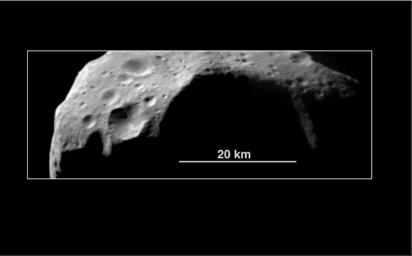
|
Abundance of Very Large Impact Craters on Mathilde
- Click the image above for a larger view
- Full-Res JPEG (640 x 398) (16.0 kB)
- Full-Res TIFF (640 x 398) (54.4 kB)
Caption:
This view of 253 Mathilde, taken from a distance of about 1,200 km (748 miles), was acquired shortly after the NEAR spacecraft's closest approach to the asteroid. In this image, the asteroid has been rotated so that the illumination appears to come from the upper left. This portion of Mathilde shows numerous impact craters, ranging from over 30 km to less than 0.5 km (18.. 0.3 miles) in diameter. Raised crater rims suggest that some of the material ejected from these craters traveled only short distances before falling back to the surface; straight sections of some crater rims indicate the influence of large faults or fractures on crater formation. The number of craters as a function of size, and the number of each size within the visible area, are similar to values seen on asteroid 243 Ida, viewed by the Galileo spacecraft in 1993. A major difference between Ida and Mathilde appears to be the abundance of very large craters: Mathilde has at least 5 craters larger than 20 km in diameter on the roughly 60% of the body viewed during the encounter.
Background Info:
Built and managed by The Johns Hopkins University Applied Physics Laboratory, Laurel, Maryland, NEAR was the first spacecraft launched in NASA's Discovery Program of low-cost, small-scale planetary missions. See the NEAR web page at http://near.jhuapl.edu/ for more details.
Cataloging Keywords:
| Name | Value | Additional Values |
|---|---|---|
| Target | 253 Mathilde | |
| System | Main Belt | |
| Target Type | Asteroid | |
| Mission | NEAR Shoemaker | |
| Instrument Host | NEAR Shoemaker | |
| Host Type | Orbiter | |
| Instrument | Multi-Spectral Imager (MSI) | |
| Detector | ||
| Extra Keywords | Crater, Grayscale, Impact, Rotation | |
| Acquisition Date | ||
| Release Date | 2000-05-07 | |
| Date in Caption | ||
| Image Credit | NASA/JPL/JHUAPL | |
| Source | photojournal.jpl.nasa.gov/catalog/PIA02478 | |
| Identifier | PIA02478 | |
